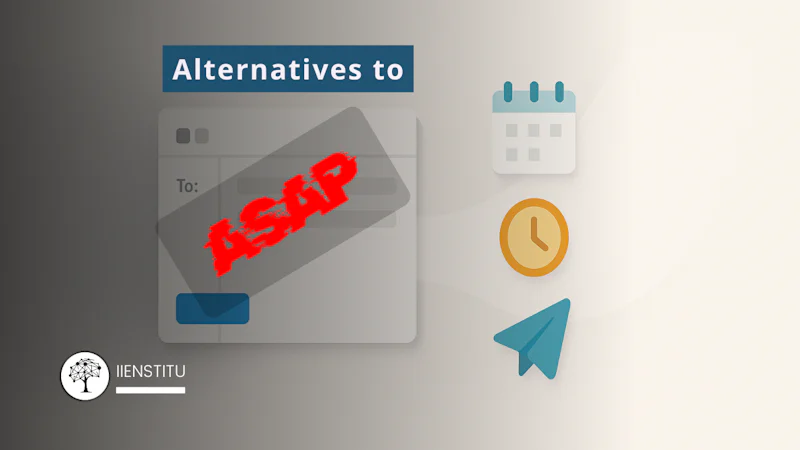“ASAP” is vague and stressful. If you’ve ever wondered how to say as soon as possible in another way, this guide gives you precise phrasing by audience, urgency, and channel. We start with why “ASAP” fails. Then we offer formal options for clients and executives, neutral choices for team workflows, and friendly lines for chat. You’ll also get an easy decision framework (R-U-M), a decoded deadline glossary, and before-and-after examples you can copy today—so you sound clear, polite, and effective.
Why Words Matter: The Problem with “As Soon As Possible” — Cut ambiguity, reduce stress
“ASAP” asks for speed without shared parameters. What’s “possible” for you may clash with someone else’s queue. That guesswork forces the recipient to invent a deadline and risks missed expectations. Large workplace surveys linked unclear expectations to higher burnout (survey, 2023). Clear, time-stamped requests improve alignment and reduce rework (management article, 2020). The fix is simple: give a specific time, a short reason, and—when needed—a time zone. That is the heart of effective communication.
Mini recap: Ambiguity causes misalignment; specificity creates momentum.
Quick check: Can a new teammate tell exactly when to act from your message?
Formal Alternatives for Professional Correspondence — Sound polished, get faster replies
When writing to clients, executives, or in legal contexts, precision and tone matter most. Add exact times, time zones, and a brief why—how strong professional emails earn quick, aligned responses.
1) “By [specific deadline]”
“Please submit the board pack by 5:00 p.m. CET on Thursday so we can circulate it for review.”
2) “Promptly”
“Kindly submit your travel receipts promptly to keep accounting on schedule.”
3) “Without delay”
“Please escalate the vendor issue without delay so we can meet compliance requirements.”
4) “Urgently”
“We require your urgent confirmation to proceed with procurement.”
5) “In a timely manner”
“Deliverables should be submitted in a timely manner to maintain the project timeline.”
6) “At your earliest convenience” (low–medium urgency)
“Please share the signed NDA at your earliest convenience.”
7) “Please expedite”
“The client moved the demo—please expedite the asset handoff.”
Before → After (mini case):
Before: “Send the updated SOW ASAP.”
After: “Please send the updated SOW by 3:00 p.m. EST today so legal can finalize overnight.”
Mini recap: In formal contexts, deadline + reason beats speed-words.
Quick check: Did you include date, time, time zone, and why?
Semi-Formal & Neutral Alternatives for Daily Team Communication — Stay clear without sounding stiff
Use these for internal emails, project threads, and cross-functional updates where you want clarity and respect for workload.
“As soon as you can” — priority without pressure.
“Could you review the brief as soon as you can? Design sequences next.”
“Soon / Quickly” — direct but calm.
“Let’s regroup quickly after stand-up.”
“Right away” — immediate, lighter than “immediately.”
“The pricing table is off—can we fix it right away?”
“Make this a priority” — useful for delegation.
“Please make this your top priority today so we hit the ad freeze.”
“Within [time window]” — flexible clarity.
“Share the draft within 24 hours so we can route feedback tomorrow.”
Before → After:
Before: “Need the copy ASAP.”
After: “Please send the homepage copy within 2 hours so dev can merge before cut-off.”
Mini recap: Pair a polite tone with a time window to prevent drift.
Quick check: Is there a clock attached to your request?
Informal Alternatives for Chats & DMs — Move fast while keeping rapport
Use these with close teammates or in Slack when context is shared. Anchor casual words to a time to keep them actionable.
“Pronto”
“Can you drop the updated logo in Drive, pronto?”
“On the double”
“We need a quick alt-text pass on the double before we publish.”
“In a snap / Lickety-split” (playful; know your audience)
“Ship the re-export in a snap so QA can close the ticket.”
“Now” (reserve for true emergencies)
“Prod is down—join the call now.”
“ASAP + anchor”
“ASAP—by 11:30 a.m.—so CS can update the status page.”
Mini recap: Casual is fine; anchor it to time.
Quick check: Did you add a specific minute or window?
Deadline Jargon, Decoded — Use EOD/COB without confusion
Short terms save space but need dates and zones to be safe.
Mini recap: Jargon travels further with date + time + time zone.
Quick check: If you wrote EOD/COB, did you add the exact timestamp?
A Simple Framework for Choosing the Right Phrase — Decide in seconds with R-U-M
Think R-U-M: Relationship, Urgency, Medium.
Relationship & hierarchy
Downward: “Please prioritize X by 2:00 p.m. so we can brief the client.”
Upward/peer: “To help me prioritize, what’s a realistic deadline for this?”
Urgency level
Critical (risk/incident): “Immediately—payment gateway is failing; rollback in 5 minutes.”
High (deadline-driven): “By 10:00 a.m. CET for the press embargo.”
Medium: “Within 48 hours so research can synthesize.”
Low: “At your earliest convenience; no dependency.”
Medium matters
Legal/exec decks: “Without delay / by [date time TZ].”
Email: “By [time] + brief reason.”
Chat: “Right away / within [window] + context.”
Text-only flow:
Fixed event (handoff/review/meeting) → exact time.
Flexible but sequenced → time window.
Active risk → immediately/now + consequence.
Mini recap: R-U-M turns “ASAP” into a precise, polite plan.
Quick check: Did you pick your phrase based on who, how urgent, and where you’re writing?
Practical Examples: Before-and-After Across Contexts — Copy, paste, ship
Client email (formal)
Before: “Please return the signed contract ASAP.”
After: “Please return the signed contract by Tuesday, 4:00 p.m. GMT, so onboarding can begin Wednesday.”
Team Slack (neutral)
Before: “Need the deck ASAP.”
After: “Could you upload the deck within the next hour? Review starts at 3.”
Incident (critical)
Before: “ASAP—site issue.”
After: “Immediately join the war room. Checkout failures spiking; rollback planned in 5 minutes.”
Mini recap: Same task, better phrasing—context shapes the ask.
Quick check: Did your rewrite add a time anchor and a why?
How to Respond to an “ASAP” Request — Stay collaborative while clarifying
Convert ambiguity into a plan: acknowledge, then clarify.
“Got it—thanks. What’s the latest I can get this to you so I can prioritize correctly?”
“Understood. Is 4:00 p.m. GMT today acceptable, or do you need it earlier?”
Mini recap: Acknowledge first; negotiate a clear, shared deadline next.
Quick check: Did you ask for a specific time that fits both schedules?
Navigating Cultural Differences with Urgency — Be clear and respectful globally
Perceptions vary. In many low-context cultures (e.g., Germany, U.S.), a direct deadline (“by 5:00 p.m.”) signals respect. In many high-context cultures (e.g., Japan, Saudi Arabia), softeners and reasons (“at your earliest convenience, as this supports tomorrow’s presentation”) land better. When in doubt, use a specific, reason-backed deadline. This reduces misread tone in distributed teams (cross-cultural communication overview, 2021).
Mini recap: Specific + respectful beats vague across cultures.
Quick check: Did you pair the deadline with a brief reason?
Choose clarity today
Trade “ASAP” for clear timing + brief reason. You’ll reduce stress, prevent rework, and strengthen trust.
Your single next step: make one default this week—“by [time] [TZ]” or “within [window]”—and hold your team to it.
Looking to level up? See our guides on effective communication, polish your professional emails, and sharpen your time management.





